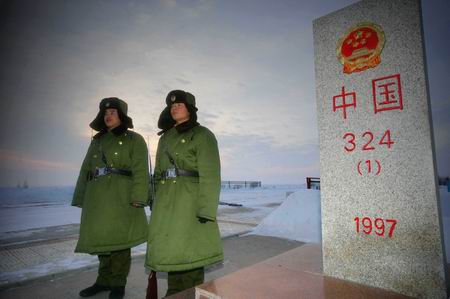From guns to greetings: Defrosting China's borders
Updated: 2007-10-03 10:03
On the winding Heilongjiang River, China's northeast border with Russia, Chinese soldiers ride in blue patrol boats, passing Russian houses on the other bank so swiftly that they soon look like matchboxes.
Patrolling the river is now routine, but it was unimaginable when relations between the two nations were strained.
"The border was once marked with barbed wire and dotted with blockhouses. Cannons were positioned against each other. The Heilongjiang River was a forbidden zone, and any approaches could have seen a flare up in the bitter bilateral relations," says Colonel Jia Lun, of the People's Liberation Army regiment stationed in Mohe County on the southern bank.
But the same border is no longer a "sensitive" area, and sentry posts and lookout points are fewer, Jia says. And similar changes have taken place along China's 22,000-kilometer land border.
According to China's white paper on National Defense in 2006, China has signed land border treaties or agreements with 12 of its 14 neighbors, with most of the demarcation disputes settled. It is currently negotiating with India and Bhutan to resolve boundary issues.
"China now shares the most peaceful borders with its neighbors since the republic was established in 1949," says Teng Jianqun, deputy secretary-general of the China Arms Control and Disarmament Association.
China saw three major military conflicts along its borders from the 1950s to the 1970s.
"Since the 1980s, no major border clashes have occurred and border troops have gradually expanded exchanges with each other," Teng says. He considers changes in the international environment, particularly the demise of the Cold War mentality, as a key factor in better border relations.
"There did exist territory disputes along the borders, but the prevailing ideological bias during the Cold War period served as a catalyst and worsened conflict," Teng says.
"The whole international climate has changed since the end of the Cold War, as a country is no longer judged as a friend or an enemy according to its political pattern, which has helped China to rebuild relations with its neighbors," he says.
More importantly, the Chinese government has employed a practical attitude in solving border issues. "Following the foreign policy of building good neighborly relations and partnership with adjacent countries, China is more willing to solve border problems through negotiations, with both the confidence brought by its rapid economic growth and the consideration constrained by its 'peaceful development' promise," he says.
"Now, border troops from China and its neighbors have very friendly exchanges and communication. Sometimes, they invite each other to parties or celebrations," he adds.
Basketball Diplomacy
"We salute every time we meet the Russian soldiers on the river or patrolling on ice during winter. We shout hello in Russian, and they greet us in Chinese," says Jia Pengfei, head of a border sentry post.
China and Russia share a 4,300-kilometer border, with most of the 3,800-kilometer eastern section sitting along the boundary of the Heilongjiang Province.
There are no bridges spanning the Heilongjiang River and the border is crossed by boat. In winter, the frozen river can carry vehicles. Russian's Amur Region has agreed with Heilongjiang Province to build a bridge that links Heihe city with Blagoveshchensk city, but the date for construction is yet to be set.
Jiang Yi, a researcher with the Chinese Academy of Social Sciences (CASS), says that as relations between the two countries improve, the two militaries are transcending old conflicts to develop a solid friendship.
In 1996 and 1997, China, Russia, Kazakhstan, Kyrgyzstan and Tajikistan signed agreements on disarmament and deepening military trust along borders, agreeing to restrict the scale, geographical limits and the number of troop exercises, to notify each other of large military activities and troop movements during emergencies and to allow temporary entry of armed forces to 100 kilometers across borders.
"These joint endeavors have improved security along China's 7,000-kilometer border with the other four countries," China's Foreign Ministry spokesman has said.
The agreements helped lay the groundwork for the Shanghai Cooperation Organization (SCO) founded in 2001, which has brought about closer cooperation among the five member states and Uzbekistan on trade, energy and fighting terrorism.
A Thaw in the Himalayas
China's southwest border with India is also growing more amicable. From busy passes to lonely sentry posts high in the Himalaya, Chinese personnel are warming to the uniformed guards on the other side.
|
|
|
||
|
||
|
|
|
|


